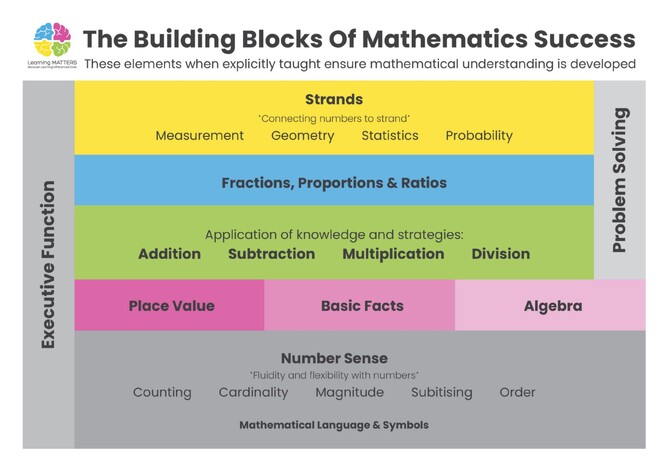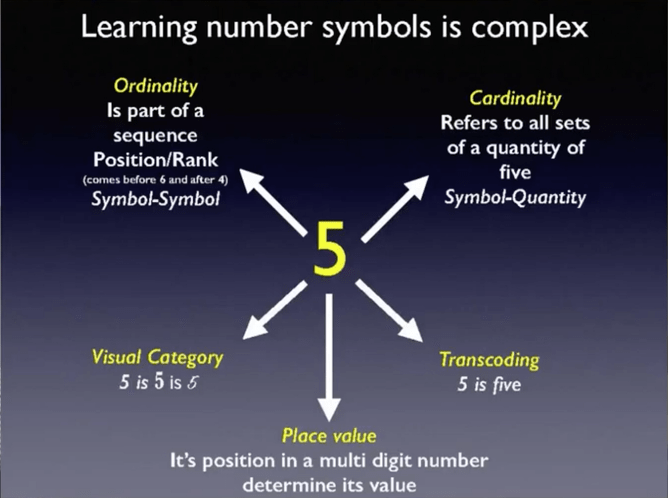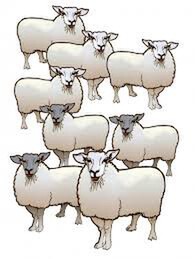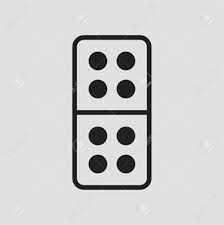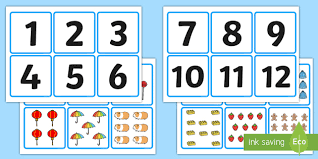Maths is everywhere. From baking in the kitchen to shopping online, measuring up a new renovation, counting sheep (not in our sleep though haha), reading eartags on cows, and budgeting, to reading the bus or train timetable. Whether we like it or not.
We simply can’t get away from it. If we, or a child we know is struggling with maths, it is likely their foundation skills aren’t secure. As an ex mathematics advisor, education consultant and someone who now specialises in evidence-based learning support, I can’t stress enough the importance of being on the right track and implementing meaningful activities.
Many of you are familiar with the Building Blocks of Reading success. But what about the Building Blocks of Maths? The image below clearly illustrates the importance of number sense as the earliest foundation skill of maths.
All too often we focus on basic facts, times tables and the operations of Addition, Subtraction, Multiplication or Division to no real avail, with no true transference and ongoing learning success.
The diagram above highlights the key aspects that research indicates we should focus on. If we know about and understand the impact these have, then when we are seeking out activities we are more likely to align them to the needs of our child and or student/s.
I would like to encourage you to begin to understand which crucial foundation skills may be lacking for your child/student. Imagine the building blocks to be like Humpty’s wall. If there are too many bottom blocks missing it is likely the wall will fall!
So let’s look at each of the aspects of Number Sense in a bid to develop a greater understanding. This will assist us to support children from an informed perspective.
Counting — ask your child to count forwards and backwards. What have you noticed? How high can they count? Can they count forwards and backwards? Can they count in 2s, 5’s, 10s? Show them numbers written down as they count and help them to get a sense of the visual representation of numbers written.
Here is a link with a few ideas for counting activities
Cardinality — Does your child understand that the last number counted in a set represents the quantity of that set? If not, show them, tell them teach them and help them realise that the count represents an amount. It is the earliest foray of developing an abstract understanding that a number represents an amount. It is impossible to solve subtraction problems when this is not secure.
Magnitude — determines whether the object is larger or smaller than other objects of the same kind. The ability to estimate depends on our sense of magnitude and our ability to distinguish relative quantities. Subtising and magnitude enable us to know the reasonableness of whether I am roundabout right. Ordering numbers will also be very difficult should we not have a sense of magnitude.
To get a sense of whether or not your child has difficulty in its area, ask them the following questions. Be sure to amend or alter the number range as necessary:
- Which number is bigger? 29 or 51
- Is 92 greater than or less than 71
- Can students make comparisons and make reasonable estimates or amounts?
- Develop their vocabulary and use of this. Greater than, Less than
This will assist you in determining whether or not developing their understanding of magnitude is secure.
This video link below is a great way to access a favourite resource, The Grapes of Math. It is full of activities to reinforce developing the concept of magnitude. https://www.youtube.com/watch?v=zWfQlou5GT4
Subitising — Subitising is the ability to recognize the number of briefly presented items without actually counting. There are two types of subitising perceptual and conceptual.
Perceptual is when we show a group of objects and the child can say how many there are without grouping or counting.
How many sheep do you see below? You likely needed to group these in some way.
Conceptual involves recognizing a number pattern as a compositeof parts and as a whole. For example, people recognize an eight-dot dominowithout counting because they see each side of the domino as 4 individualdots and as a four — they see the domino as composed of two groups of four and as one eight.
Conceptual subitizing develops from counting and patterning. Conceptualsubitizing helps develop number sense and arithmetic skills. It is super important. We can teach this through explicit instruction using materials such as tens frames. I have included a fun little ditty here for you to use.
Last but not least by any means….
Order — this is somewhat obvious I hope. Check to see if your child can order in various ways the number range they are working within. 0–20, 0–100, 0–1000. Whatever you do here, be sure to include multisensory aspects to help develop the meaning of the ordering and to give the visual representation and a hook. We want our children to understand why for example 18 comes after 17. They won’t get this solely by writing out numbers in order. We need a multisensory representation along with the symbolic number.
I trust this information assists you to not only have a greater understanding of the complexities of mathematics but, that it also gives you a way to delve into the ‘WHY’ your child or student may be having difficulty with mathematical learning.
Be ok to sit in the space of securing foundation skills (Number Sense) first. Focussing here will ensure much greater success in the long term. Have fun, keep it real, multisensory and full of play.
Wishing you all the best as you make a difference to those you work with.
WRITTEN BY
Carla is the Founder and Director of Learning MATTERS Ltd. Carla has been a successful school Principal, Mathematics Advisor and Classroom teacher.

